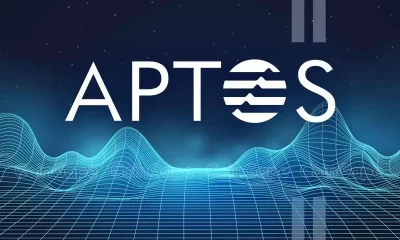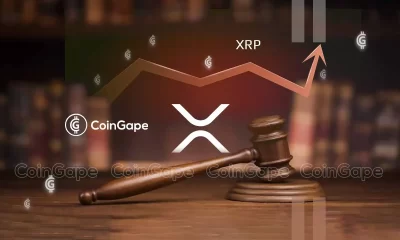mica
Tether ends support for EURT stablecoin amid MiCA compliance
Published
5 months agoon
By
admin

Tether is discontinuing its support for the Euro-pegged stablecoin EURT, and will no longer accept new issuance requests.
The Tether (USDT) issuer notified its community and the broader industry that the company has ended EURT support via a blog post on Nov. 27.
According to the announcement, the decision to halt the minting of the Euro-pegged stablecoin comes amid the industry’s adjustment to the regulatory environment around stablecoins. In particular, Tether has taken this step in response to the European Union’s stablecoin regulation as outlined in the Markets in Crypto-Assets regulation.
MiCA rolled out for stablecoins in June, with full implementation of the comprehensive regulatory regime set for December 30, 2024.
“After careful consideration, we have made the decision to discontinue support for EUR₮. As such, Tether has ceased minting EUR₮, with the last acquisition request processed in 2022, and new EUR₮ issuance requests are no longer accepted,” Tether wrote.
The USDT issuer is choosing to end EURT support “until a more risk-averse framework is in place.” Customers with EURT balances on blockchains have until November 27, 2025, to redeem their holdings.
Tether previously disclosed plans to halt EURT across several chains, including EOS, Omni, Kusama and Algorand. However, this has changed with stringent rules around asset-referenced tokens. Some exchanges announced the delisting of the fiat-backed token this year. They include OKX, Bitstamp and Coinbase.
As the crypto platform takes this step, it notes that its focus will now be on other initiatives. These include Tether’s support for recently launched MiCA-compliant stablecoins USDQ and EURQ.
Tether recently invested in USDQ and EURQ issuer Quantoz Payments, which crypto.news highlighted last week. Tether’s blockchain technology solution Hadron by Tether will power this integration.
The EURT stablecoin was launched in 2016.
Source link
You may like


AVAX Falls 2.1% as Nearly All Assets Trade Lower


What is a VTuber, and how do you become one in 2025?


Top Expert’s Update Sets $10 Target


How Academia Interacts With The Bitcoin Ecosystem


AB DAO and Bitget Launch Dual Reward Campaign, Distributing $2.6M Worth of $AB Globally


AI crypto tokens at risk as Nvidia faces restrictions on China exports
crypto taxes
Ukraine Considers Up to 23% Personal Income Tax on Crypto in Newly Proposed Tax Scheme
Published
7 days agoon
April 9, 2025By
admin
Ukraine’s top financial regulator is floating the idea of taxing cryptocurrency as personal income, with possible carveouts for certain foreign asset-backed stablecoins, under a newly proposed taxation matrix published on Tuesday.
In a translated letter introducing the potential new approach, Ruslan Magomedov, head of Ukraine’s National Securities and Stock Market Commission, said that effective tax policy is a necessary step in preventing financial abuse and facilitating the “legal and responsible use of digital assets.”
“Establishing fair and understandable taxation rules is also a prerequisite for attracting investment and integrating the Ukrainian virtual asset market into the global financial market,” Magomedov added.
Under the NSSMC’s suggested tax scheme, certain crypto transactions — essentially those in which non-stablecoin cryptocurrencies are cashed out for fiat currency or exchanged for goods or services, and during which there were no financial losses from the transaction — would be taxed at Ukraine’s standard personal income tax rate of 18%, plus the additional 5% wartime levy that went into effect last December.
Crypto-to-crypto transactions would not be subject to taxation under the proposed tax matrix, which is in line with how several other European countries including Austria and France, as well as crypto-friendly jurisdictions like Singapore, handle crypto taxation.
Because Ukraine’s tax code exempts any income generated from transactions with foreign exchange values from being taxed, the NSSMC suggested “it makes sense to consider a preferential rate or exemption from taxation” for foreign asset-backed stablecoins and certain asset-referenced tokens (ARTs). The suggested preferential tax rate under the matrix could be either 5% or 9%.
The matrix also offered a variety of taxation options for other types of crypto transactions, including mining, which the NSSMC suggested could be considered a “business activity”; staking, which the regulator said could either be “considered as business captive income” or taxed only at the cash-out stage; as well as hard-forks and airdrops, which the regulator said could either be taxed as ordinary income or only at the cash-out stage.
Ukraine had previously introduced a draft law similarly amending the country’s tax code to cover cryptocurrency in 2023. A 2024 analysis from Swiss blockchain analytics firm Global Ledger found that Ukraine could stand to collect over $200 million in annual taxes from crypto transactions.
Ukrainian President Volodymyr Zelensky officially legalized the country’s cryptocurrency sector in 2022, determining the industry’s regulators and giving them the go-ahead to create specific regulations. The National Bank of Ukraine is currently working on a draft law based on the European Union’s (EU) Markets in Crypto Assets (MiCA) regulation.
Ukraine has been a candidate for EU membership since 2022.
CoinDesk reached out to the NSSMC for a comment.
Source link


The German Federal Financial Supervisory Authority, BaFin, has ordered Ethena GmbH to stop all public sales of its stablecoin USDe.
This comes after the German financial markets regulator found serious flaws in Ethena GmbH’s USDe approval process.
Per the BaFin announcement on March 21, 2025, the public sales of Ethena (ENA)’s synthetic dollar Ethena USDe violates the European Union’s Markets in Crypto Asset Registration rules.
With stablecoin regulation being one of the EU’s major enforcement priorities, a lack of MiCAR compliance has become a key obstacle for stablecoin issuers.
“The BaFin also has reasonable grounds to suspect that Ethena GmbH in Germany sells securities in the form of sUSDe tokens from Ethena OpCo. Ltd. without the required prospectus,” the regulator said.
BaFin has therefore ordered Ethena to immediately cease any sales to the public.
Enforcement measures
The enforcement measures include a freeze on USDe reserves held by Ethena’s custodian. Additionally, Ethena GmbH is required to shut down its website portal and stop registering new customers.
While Ethena GmbH has been prohibited from selling USDe, the order only applies to primary sales. In this case, BaFin’s order does not affect secondary sales. Ethena Labs issued a statement on X following the news.
“We were informed today that Ethena GmbH’s application under the MiCAR regulatory framework will not be approved. While we are disappointed by this decision, we will continue to evaluate alternative frameworks.”
According to the crypto platform, BaFin’s order doesn’t affect the stablecoin’s listing.
The decision will also not affect minting and redemption through Ethena Limited, the company’s entity registered in the British Virgin Islands, which handles the majority of USDe minting.
“USDe remains fully backed [and] no assets have been “frozen”” Ethena noted.
Source link
24/7 Cryptocurrency News
Binance To Delist Non-MiCA Compliant Stablecoin Trading Pairs In Europe
Published
1 month agoon
March 3, 2025By
admin
Cryptocurrency exchange giant Binance again nabbed significant investor attention with its latest announcement on Monday. The crypto trading platform revealed that it will be delisting all non-MiCA-compliant stablecoin trading pairs in the EEA (European Economic Region) shortly.
Binance To Delist Non-MiCA Compliant Stablecoin Trading Pairs In EEA
According to an official Binance announcement on March 3, the crypto exchange is implementing changes to non-MiCA-compliant stablecoin trading pairs in the EEA region. As per the announcement, trading pairs with USDT, FDUSD, TUSD, USDP, DAI, AEUR, UST, USTC, and PAXG will be delisted for EEA users on March 31.
However, MiCA-compliant stablecoins pairs, such as USDC, EURI, and fiat pairs (EUR) will remain available. Simultaneously, the crypto exchange also urged EEA users to convert any remaining non-MiCA compliant stablecoin holdings (e.g., USDT) to USDC, EURI, or EUR.
Why Is Binance Delisting Stablecoin Trading Pairs?
Meanwhile, it’s also noteworthy that Binance rolled out its latest delisting announcement following recent stablecoin-related guidelines from EU authorities. As a result, the top crypto exchange is making changes to the availability of non-MiCA-compliant stablecoins in the EEA.
What’s More?
Starting March 31 at 23:59 UTC, the exchange will restrict the availability of Spot trading pairs pegged to non-MiCA Compliant Stablecoins. Further, starting March 27 at 07:00 UTC, any non-MiCA compliant Margin trading pairs will also be delisted for EEA users.
Other services like trading bots, earn, and loans will also be impacted for users. Nevertheless, the exchange clarified that users will still be able to sell any remaining non-MiCA-compliant stablecoin holdings after March 31.
Binance Continues Modifying Trade Offerings
Simultaneously, with the abovementioned endeavor weighing in, the leading cryptocurrency exchange further cements its top ranking in the market. Notably, Binance has secured the top spot by constantly enhancing trade offerings in line with market needs.
CoinGape recently reported that the exchange extended support to the Ethernity Chain (ERN) token swap process, sparking an ERN price upswing. On the other hand, the CEX also delisted key BNB and ETH trading pairs, adding to its foray into revolutionized offerings.
Coingape Staff
CoinGape comprises an experienced team of native content writers and editors working round the clock to cover news globally and present news as a fact rather than an opinion. CoinGape writers and reporters contributed to this article.
Disclaimer: The presented content may include the personal opinion of the author and is subject to market condition. Do your market research before investing in cryptocurrencies. The author or the publication does not hold any responsibility for your personal financial loss.
Source link

AVAX Falls 2.1% as Nearly All Assets Trade Lower

What is a VTuber, and how do you become one in 2025?

Top Expert’s Update Sets $10 Target

How Academia Interacts With The Bitcoin Ecosystem

AB DAO and Bitget Launch Dual Reward Campaign, Distributing $2.6M Worth of $AB Globally

AI crypto tokens at risk as Nvidia faces restrictions on China exports

Coinbase Urges Australia to Vote for Crypto Progress in May

How High Would Pi Network Price Go If Pi Coin Adopts Transparency to Avoid Mantra Pitfalls

XRP’s ‘Rising Wedge’ Breakdown Puts Focus on $1.6 Price Support

China selling seized crypto to top up coffers as economy slows: Report

Ethereum Price Dips Again—Time to Panic or Opportunity to Buy?

The Inverse Of Clown World”

Bitcoin Indicator Flashing Bullish for First Time in 18 Weeks, Says Analyst Who Called May 2021 Crypto Collapse

3iQ and Figment to launch North America’s first Solana staking ETF

Bitcoin Miners Are Selling More BTC to Make Ends Meet: CryptoQuant

Arthur Hayes, Murad’s Prediction For Meme Coins, AI & DeFi Coins For 2025

Expert Sees Bitcoin Dipping To $50K While Bullish Signs Persist

Aptos Leverages Chainlink To Enhance Scalability and Data Access

Bitcoin Could Rally to $80,000 on the Eve of US Elections

Crypto’s Big Trump Gamble Is Risky

Sonic Now ‘Golden Standard’ of Layer-2s After Scaling Transactions to 16,000+ per Second, Says Andre Cronje

Institutional Investors Go All In on Crypto as 57% Plan to Boost Allocations as Bull Run Heats Up, Sygnum Survey Reveals

Ripple-SEC Case Ends, But These 3 Rivals Could Jump 500x

3 Voting Polls Show Why Ripple’s XRP Price Could Hit $10 Soon

Has The Bitcoin Price Already Peaked?

A16z-backed Espresso announces mainnet launch of core product

The Future of Bitcoin: Scaling, Institutional Adoption, and Strategic Reserves with Rich Rines

Xmas Altcoin Rally Insights by BNM Agent I

Blockchain groups challenge new broker reporting rule

I’m Grateful for Trump’s Embrace of Bitcoin
Trending

 24/7 Cryptocurrency News5 months ago
24/7 Cryptocurrency News5 months agoArthur Hayes, Murad’s Prediction For Meme Coins, AI & DeFi Coins For 2025

 Bitcoin3 months ago
Bitcoin3 months agoExpert Sees Bitcoin Dipping To $50K While Bullish Signs Persist

 24/7 Cryptocurrency News3 months ago
24/7 Cryptocurrency News3 months agoAptos Leverages Chainlink To Enhance Scalability and Data Access

 Bitcoin5 months ago
Bitcoin5 months agoBitcoin Could Rally to $80,000 on the Eve of US Elections

 Opinion5 months ago
Opinion5 months agoCrypto’s Big Trump Gamble Is Risky

 Altcoins3 months ago
Altcoins3 months agoSonic Now ‘Golden Standard’ of Layer-2s After Scaling Transactions to 16,000+ per Second, Says Andre Cronje

 Bitcoin5 months ago
Bitcoin5 months agoInstitutional Investors Go All In on Crypto as 57% Plan to Boost Allocations as Bull Run Heats Up, Sygnum Survey Reveals

 Price analysis5 months ago
Price analysis5 months agoRipple-SEC Case Ends, But These 3 Rivals Could Jump 500x



✓ Share: